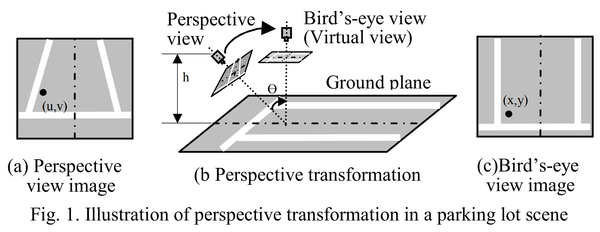Birds Eye View/Introduction/Research
Introduction
In general, camera-on-vehicle has serious perspective effect as Fig. 1(a). Because of the perspective effect, the driver can’t feel distance correctly and advanced image processing or analysis becomes difficult also. Consequently, as Fig. 1(b), perspective transformation is necessary. The raw images have to be transferred into bird’s-eye view as Fig. 1(c). [2]

To obtain the output bird-s eye view image a transformation using the following projection matrix can be used. It maps the relationship between pixel (x,y) of bird's eye view image and pixel (u,v) from the input image.
[math]\displaystyle{ \begin{bmatrix} x'\\ y'\\ w' \end{bmatrix} = \begin{bmatrix} a_{11} \;\; a_{12} \;\; a_{13}\\ a_{21} \;\; a_{22} \;\; a_{23}\\ a_{31} \;\; a_{32} \;\; a_{33} \end{bmatrix} \begin{bmatrix} u\\ v\\ w \end{bmatrix} \;\; where \;\;\;\; x = \frac{x'}{w'} \;\; and \;\;\;\; y = \frac{y'}{w'}. }[/math]
The transformation is usually referred as Inverse Perspective Mapping (IPM) [3]. IPM takes as input the frontal view, applies a homography and creates a top-down view of the captured scene by mapping pixels to a 2D frame (Bird's eye view).
In practice, IPM works great in the immediate proximity of car, for example, and assuming the road surface is planar. Geometric properties of objects in the distance are affected unnaturally by this non-homogeneous mapping, as shown in Figure 2 left image. This limits the performane of applications in terms of accuracy and distance where they can be applied reliably. The right image can be achieved by applying several post transformation techniques like Incremental Spatial Transformer [4]. However, this project uses a basic IPM approach as a demonstration.
There are 3 assumptions when working without post transformation techniques:
- The camera is in a fixed position with respect to the road.
- The road surface is planar.
- The road surface is free of obstacles.